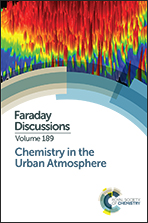Spiers Memorial Lecture
Introductory lecture: chemistry in the urban atmosphere
Abstract
The urban atmosphere is characterised by a multitude of complex processes. Gaseous and particulate components are continuously emitted into the atmosphere from many different sources. These components are then dispersed in the urban atmosphere via turbulent mixing. Numerous chemical reactions modify the gas phase chemistry on multiple time scales, producing secondary pollutants. Through partitioning, the chemical and physical properties of the aerosol particles are also constantly changing as a consequence of dispersion and gas phase chemistry. This review presents an overview of the involved processes, focusing on the contributions presented at this conference and putting them into a broader context. Advanced methods for aerosol source apportionment are presented as well, followed by some aspects of health effects related to air pollution.
- This article is part of the themed collections: The Spiers Memorial Lectures and Chemistry in the Urban Atmosphere

 Please wait while we load your content...
Please wait while we load your content...